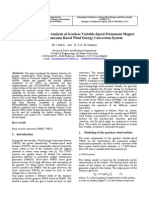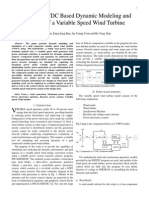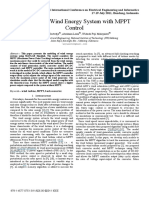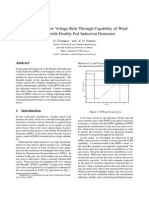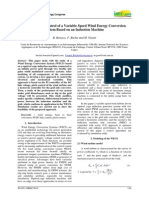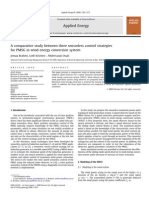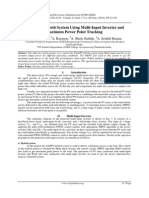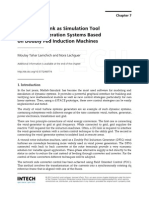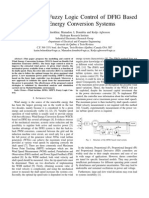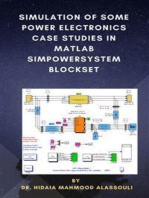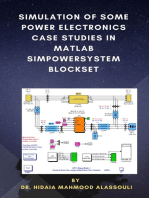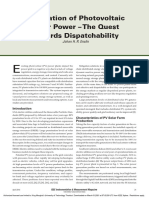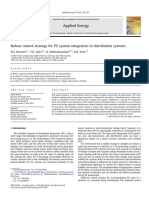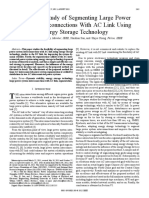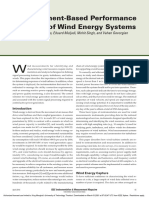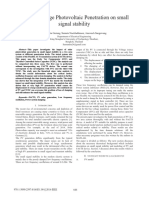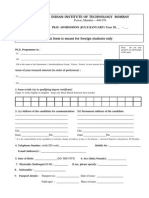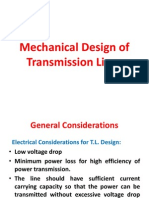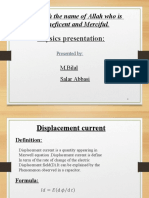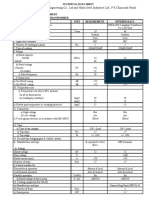Modeling and Control of Direct Drive Variable Speed Stand-Alone Wind Energy Conversion Systems
Modeling and Control of Direct Drive Variable Speed Stand-Alone Wind Energy Conversion Systems
Uploaded by
Samundra GurungCopyright:
Available Formats
Modeling and Control of Direct Drive Variable Speed Stand-Alone Wind Energy Conversion Systems
Modeling and Control of Direct Drive Variable Speed Stand-Alone Wind Energy Conversion Systems
Uploaded by
Samundra GurungOriginal Description:
Original Title
Copyright
Available Formats
Share this document
Did you find this document useful?
Is this content inappropriate?
Copyright:
Available Formats
Modeling and Control of Direct Drive Variable Speed Stand-Alone Wind Energy Conversion Systems
Modeling and Control of Direct Drive Variable Speed Stand-Alone Wind Energy Conversion Systems
Uploaded by
Samundra GurungCopyright:
Available Formats
Modeling and Control of Direct Drive Variable Speed
Stand-Alone Wind Energy Conversion Systems
Mohamed Hilmy
1
, Mahrous E. Ahmed
1
, IEEE Member, Mohamed Orabi
1
, IEEE Senior Member and Mohamed El-
Nemr
2
, IEEE Member
1
APEARC, South Valley University, Aswan City, Egypt
2
Tanta University, Tanta, Egypt
Abstract -This paper proposes a small wind energy
conversion system comprises permanent magnet synchronous
generator (PMSG), uncontrolled rectifier, conventional H-Bridge
inverter and dc-dc bi-directional converter. The dc link capacitor
is connected to a storage system through Bi-directional power
flow link. A hybrid pulse width modulation (HPWM) controller
is used to regulate the ac load voltage and frequency while the
power flow control is achieved by bi-directional dc/dc converter.
A maximum power point tracking (MPPT) control is employed
where the storage system is used to feed the required power
balance between the wind power and the load power. The
complete system is studied, analysed and simulated using PSIM
to validate the system performance. Finally, simulation and
experimental results have been provided.
Index Terms - PMSG, HPWM, Bi-directional Converter, and
Power flow controller.
I. INTRODUCTION
Wind energy is clean silent and emission-free source of
energy. Using small wind energy conversion system increases
rapidly nowadays all over the world due to its availability,
small size, high performances, low cost installation, and it has
low weight compared to induction generators. PMSG is used
more frequently in small wind turbine application due to its
robustness, reliability and high efficiency when connected to
variable speed wind turbine [1]. Optimum operation of wind
energy conversion system is achieved by running the wind
turbine at variable speed while using gear box increases the
mechanical losses and thus decreases generator efficiency so
the proposed system is direct drive. Most papers [2], [3], [4]
are considering using PMSG and normally include controlled
three phase ac to dc conversion which can be used to track
maximum power to capture the maximum available wind
power from the wind turbine besides achieving unity power
factor at the generator side. The dc/ac inverter is used to
regulate the load voltage and frequency and for stand-alone
systems. Additionally, a battery power flow controller is used
to balance the load power as the wind power changes [3], [4].
According to grid connected systems, the MPPT control is
achieved using the dc/ac inverter and the controller achieve
unity power factor at the grid side.
This paper is targeting small wind turbine applications
which is required to work offline and with a cost effective.
The proposed system is composed of a wind energy
conversion system using PMSG with cheap conventional
uncontrolled rectifier and dc/dc bi-directional converter that
connected to the dc-bus voltage to manage and control the
power delivered to the load [5]. The storage system can be
charged / discharging based on the power delivered from the
wind. Additionally, a MPPT control algorithm is employed to
achieve maximum power from the wind by employing an
incremental conductance method [6] which changes the
generator loading to reach the desired optimum condition
using the bi-directional converter. A HPWM controller is
applied to maintain load voltage constant also to reduce
inverter switching losses and thus improving the efficiency of
the overall system.
II. THE PROPOSED WIND ENERGY CONVERSION SYSTEM
CONFIGURATION
The complete system configuration is shown in Fig 1. The
system comprises small wind turbine, PMSG, conventional
single phase inverter (H-Bridge) and bi-directional dc/dc
converter. 1.25 kW wind turbine power is used, the maximum
available wind speed is assumed to be 12m/s and the output
voltage is 400V
dc
. Direct drive PMSG is connected to the
wind turbine. Due to its robustness, reliability and efficiency
can be improved by reducing the generator losses by operating
at unity power factor. Figure 1 indicates the complete control
technique of the proposed system; three arms LC filters are
applied across the generator terminals to reduce the generator
voltage and current harmonics. Uncontrolled rectifier is
connected through the three phase LC filter. The bidirectional
converter used to control charging and discharging battery
pack beside MPPT of the wind energy conversion system. A
conventional single phase dc/ac inverter is connected through
the dc link capacitor. The load is connected to the inverter
through a second order filter (LC filter) to eliminate the output
voltage and current harmonics. The well known HPWM is
applied to the inverter to regulate the load voltage and
frequency [7].
A. Wind turbine model
The wind turbine model has been designed from the
characteristics equations which describe the whole small wind
system [8].
Proceedings of the 14th International Middle East Power Systems Conference (MEPCON10), Cairo University, Egypt, December 19-21, 2010, Paper ID 276.
742
Fig. 1: Circuit diagram of the wind energy conversion system on PSIM.
The wind turbine output power is proportional to cubic wind
speed, rotor swept area, rotor power coefficient and air density
as given by (1). The relation between rotor power coefficients
as a function of tip-speed ratio at different pitch angles is given
in (2) and (3) which is empirical equation. Equations (2) and
(4) are used to achieve optimum design of wind turbine. Input
torque to the PMSG is governed by (5).
P
= 0.5 A v
(, ) (1)
C
(, ) = C
+ C
(2)
(3)
=
(4)
= (5)
Where: v
is the wind speed (m/s), A is the rotor swept area
(m
2
), C
is the rotor power coefficient, is the air density
(kg/m
3
), P
the wind power (W), T is the shaft torque (N.m),
tip-speed ratio, and is the pitch angle in degrees. The values
of the constants are: C
=0.5176, C
= 116, C
=0.4, C
=5,
C
=21 and C
= 0.0068. The aforementioned equations are
characterizing the wind turbine system. From these equations
the relationship between wind turbine power and generator
speed at various wind speed can be drawn as shown in Fig. 2.
The relationship between rotor power coefficient C
and tip-
speed ratio at various pitch angles () can be drawn as shown
in Fig. 3.
The designed wind turbine model is simulated using PSIM to
validate the actual wind turbine performance and it is
connected to the PMSG to change the mechanical input torque
according to the aforementioned equations. Also the PMSG
model should take the mechanical losses into account. Since
the input torque is variable thus the generator output voltage
frequency are variable too. A controller will be employed to
fix both the magnitude and frequency and thus the load will be
fed by a constant voltage / frequency supply.
Fig. 2: The wind turbine output power versus rotor speed.
Fig. 3: Charecteristics of rotor power coefficient over tip-speed ratio at
different pitch angles.
0 500 1000 1500 2000 2500 3000
0
500
1000
1500
2000
2500
Generator Speed (rpm)
M
e
c
h
a
n
i
c
a
l
P
o
w
e
r
(
W
)
12m/s
11m/s
10m/s
9m/s
0 2 4 6 8 10 12 14 16 18
0
0.1
0.2
0.3
0.4
0.5
Tip-Speed Ratio
R
o
t
o
r
P
o
w
e
r
C
o
e
f
f
i
c
i
e
n
t
(
C
p
)
B=0
B=5
B=10
B=15
743
B. Maximum Power Point Tracking (MPPT) Algorithm
To get fast tracking for maximum power, it is preferable
to use incremental conductance method [6] which is based on
the fact that maximum power occurs when the variation of
dP/dV = 0. Since the dc power across uncontrolled rectifier is
governed by equation P = VI , from which the following
equation:
= I + V
(6)
The following constraints are used to calculate the MPPT using
the incremental conductance method:
I +V
= 0 At MPP (7)
I +V
> 0 Left to MPP (8)
I +V
< 0 Right to MPP (9)
Fig. 4: Flow chart of the incermental conductance MPPT method.
Equations (7), (8) and (9) are used to determine the location of
the operating point. Based on these equations the controller
can easily take the decision of increasing or decreasing the
operating voltage to reach maximum power point. Figure 4
shows the flow chart for the employed MPPT.
C. Bi-directional dc/dc Converter
The bi-directional converter connected across the dc-link
to adjust power flow to/from the battery storage system [9].
When the wind power is larger than the load power, the buck
switch (S6) is activated to charge the battery pack. On
contrary, when the wind power is smaller than the load power
the boost switch (S5) is activated to discharge the battery pack.
The MPPT calculation technique is used to feed the reference
signal to the voltage controller of the bi-directional converter
to adjust the dc-link voltage to operate the small wind energy
conversion system at maximum power. The power flow
controller determines which switch buck switch (S6) or boost
switch (S5) should be activated to make the power balance
between the wind power and the load power [5]. In achieving
both power flow control and maximum power point control,
the dc bus voltage will be variable. In this case, the buck
switch (S6) is activated only when the input wind power is
larger than the specified load power. A certain time delay is
considered between the buck and boost switches to guarantee
that the two switches dont operate at the same time.
D. H- Bridge Inverter
H-bridge inverter is being used as a dc/ac converter which
can regulate the load voltage and frequency. A hybrid pulse
width modulation controller (HPWM) method is applied to
reduce the switching losses in a full-bridge inverter in which
two switches of the four switches of the H-bridge inverter
operate at high frequency and the other two switches operate
at low frequency (load frequency) [7]. Also, it is applied to
regulate the load voltage at 220V.
E. Complete system efficiency
To study the system efficiency, the whole WECS has been
simulated for different values of output powers. Fig. 5 shows
the efficiency of the overall system versus the output power. It
has been found that the efficiency will be low at low output
powers. Fig. 5 indicates that the efficiency will be greater than
90% for output power greater than 500 W and it will
decreases rapidly at more lighter loads. Obviously the best
operation of that system can be attained near the rated values.
III. SIMULATION RESULTS
The complete system is built inside PSIM software
package and the power stage parameters are listed in Table 1.
The whole system has been simulated under two step change
in the wind speed from 10 m/s to 12 m/s at t=0.4s. Then step
744
change from 12m/s to 8m/s at t=0.7s. Simulation results show
the performance of the whole system. Fig. 6 and Fig. 7 show
the three phase generator voltages and currents respectively
due to the above mentioned step change in wind speed. It can
be noted that both voltages and currents are almost sinusoidal
waveforms. Fig. 8 depicts the dc-link voltage and the battery
charging current according to MPPT algorithm. The figure
shows the merit of the controller that can maintain the dc bus
voltage at constant values based on the power captured from
the wind. In addition, it shows that the battery current can
change its direction to balance and keep the load power
constant. For the chosen system, the battery is almost charging
except for very short time it discharges. Figure 9 shows the
turbine power (the input torque to the PMSG), the input power,
the load power, and the battery power. It is clear that the load
power equals the input power plus the battery power, thus the
power balance is satisfied at the dc bus terminal. Figure 10
shows the rotor power coefficient which is almost constant
near 0.42 which is confirms the MPPT operation even if under
wind speed step change. The HPWM switches control signals
are shown in Fig. 11. As mentioned before, two switched will
be operated at high switching frequency while the other two
switches will be operated at power frequency which is 50 Hz.
The ac output load voltage and current are shown in Fig. 12.
Obviously, the load voltage magnitude is almost constant
during the step change because of the HPWM controller is
employed to adjust it. Also, the current is lagging the voltage
with certain phase angle due to the inductance of the load.
Fig. 5: Complete system efficiency versus output power
TABLE I
PARAMETERS OF WIND ENERGY SYSTEM
Parameters Values
Wind turbine power rating 1.25kW
Load RMS Voltage 220V
Output ac load voltage frequency 50Hz
Bi-directional converter switching frequency 100kHz
Inverter switching frequency
10kHz
Input three phase LC filter 0.5mH and 120F
dc-link capacitor value 1.5 mF
Bi-directional converter inductance 0.5mH
Fig. 6: The three phase generator voltages due to step change in wind
speed from 10m/s to 12m/s at 0.4s.
Fig. 7: The three phase generator currents due to step change in wind
speed from 10m/s to 12m/s at 0.4s.
Fig. 8: Dc link and battery current variations at various wind speed.
90
90.2
90.4
90.6
90.8
91
91.2
250 500 750 1000 1250
E
f
f
i
c
i
e
n
c
y
%
Output Power (W)
745
Fig. 9: Turbine, load and battery power variation at various input torque.
Fig. 10: Rotor power coefficient at two step change in wind speed.
Fig. 11: HPWM control signals for the four switches.
IV. EXPERIMENTAL RESULTS
To validate the proposed system, an experimental
prototype of the uncontrolled rectifier and for the conventional
inverter has been built, experimentally tested, and compared
with the simulation results. Figure 13 shows the experimental
set up. A single phase load with 440 was used. The inverter
circuit was built using power MOSFET of type 16N60 as
switches, and the three-phase bridge rectifier was built of
diode type 8ETl06. The three-phase voltages are supplied
from three-phase ac source. The inverter switching
frequencies are 50 Hz for two switches and 10 kHz for the
other two switches. The switching signals are generated using
an FPGA of type XC3S400 as a controller. Figure 14 shows
the input three-phase ac source voltages with 120 peak-to-
peak voltage and 50 Hz frequency. Thus the dc-link voltage
obtained is shown in Fig. 15 with amplitude of approximately
60 V. The four switches control signals are indicated in Fig.
16 with two switches operate at low frequency and two
switches with high frequency. Open loop control applied to
the H-bridge inverter to convert it to single phase voltage
across the load terminals as shown in Fig 17. The load voltage
and load current are not pure sinusoidal due to the small value
of the ac capacitor used for the inverter prototype.
Fig. 12: Load voltage and load current.
Fig. 13: Experimental setup.
Fig. 14 The input generator voltage.
746
Fig. 15: The Dc-link voltage.
Fig. 16: H-bridge inverter four switches pulses.
Fig. 17: Load voltage over the reference voltage.
IV. CONCLUSION
This paper proposes a small wind turbine energy
conversion system for isolated load applications. The system
includes a PMSG, uncontrolled rectifier, battery storage
system. A MPPT control algorithm based on the incremental
conductance method is employed to harvest the maximum
power from the wind. This maximum power is used as a
reference signal to operate the power flow controller required
by the storage battery system. This storage battery system is
use to balance the power comes from the wind and the power
required by the load. A bi-directional dc/dc converter is used
to change the dc bus voltage to achieve MPPT and control the
power flow in the same time. A HPWM controller also is used
across the inverter side to regulate the load terminal voltage
and reduce switching losses. Simulation and experimental
results have been provided to validate the system.
ACKNOWLEDGMENT
The authors gratefully thank the ministry of Science, Egyptian
science and technology development funds (STDF project No
658), for supporting this project.
REFERENCES
[1] A. O. Di Tommaso, R. Miceli, G. R. Galluzzo and M. Trapanese,
Efficiency Maximization of Turbines Permanent Magnet Synchronous
Generators Coupled to Wind turbines , Power Electronics Specialists
Conference, PESC 2007. pp, 1267 - 1272, Orlando, 17-21 June 2007.
[2] N. A. Orlando, M. Liserre, V. G. Monopoli, R. A. Mastromauro, and A.
DellAquila, Comparison of power converter topologies for permanent
magnet small wind turbine system , IEEE International Symposium on
Industrial Electronics, ISIE 2008. pp, 2359 - 2364, Cambridge, June 30
2008-July 2 2008.
[3] X. Yuan, F. Wang, R. Burgos, Y.Li and D. Boroyevich, Dc-link
Voltage Control of Full Power Converter for Wind Generator Operating
in Weak Grid Systems , Proc. of 23
th
An. Conf. of IEEE Applied Power
Electronics , APEC-2008. pp, 761 - 767, Austin, 24-28 Feb. 2008.
[4] M.M. Reis, B. Soares, L.H.S.C. Barreto, E. Freitas, C.E.A. Silva, R.T.
Bascop and D.S. Oliveira Jr , A Variable Speed Wind Energy
Conversion System Connected To The Grid For Small Wind Generator ,
Proc. of 23
th
An. Conf. of IEEE Applied Power Electronics , APEC-
2008. pp, 751 - 755, Austin, 24-28 Feb. 2008.
[5] L. N. Modran , Power Flow Control on Wind Power Plant with
Permanent Magnet Synchronous Generator , Proc. of 11th An. Conf. of
Optimization of Electrical and Electronic Equipment, OPTIM 2008. pp,
419 - 426, Brasov, 22-24 May 2008.
[6] T. Esram and P.L. Chapman, Comparison of Photovoltaic Array
Maximum Power Point Tracking TechniquesIEEE Transactions On
Energy Conversion, Vol. 22, No. 2, June 2007.
[7] R. S. Lai and K. D. T. Ngo, A PWM Method for Reduction of
Switching Loss in a Full-Bridge Inverter , Proc. of 9
th
An. Conf. of
IEEE Applied Power Electronics and Exposition , APEC-1994.Vol.1,
pp, 122 - 127, Orlando, 3-17 Feb 1994.
[8] T. Tafticht, K. Agbossou, A. Cheriti, M.L. Doumbia, Output Power
Maximization of a Permanent Magnet Synchronous Generator Based
Stand-alone Wind Turbine , IEEE International Symposium on
Industrial Electronics, ISIE 2006. pp, 2412 - 2416, Montreal, 9-13 July
2006.
[9] O. C. Onar, Y.Gurkaynak and A. Khaligh, A Brushless DC Generator
&Synchronous Rectifier for Isolated Telecommunication Stations ,31
st
International of Telecommunications Energy,INTELEC-2009, pp, 1- 6,
Incheon, 18-22 Oct. 2009.
[10] N. V. S. K. Srighakollapu and P. S. Sensarma, Sensorless Maximum
Power Point Tracking Control in Wind Energy Generation using
Permanent Magnet Synchronous Generator , Proc. of 34
th
An. Conf. of
Industrial Electronics, IECON-2008. pp, 2225 - 2230, Orlando, 10-13
Nov. 2008.
747
You might also like
- Arcode Parameter Manual.V121.enDocument36 pagesArcode Parameter Manual.V121.enRaul Villena100% (9)
- Watts 3 w AU p ρC 2 1 m PDocument7 pagesWatts 3 w AU p ρC 2 1 m PAbhishek SinghNo ratings yet
- New Control Strategies of A Small Size Wind Generation System For Battery ChargingDocument6 pagesNew Control Strategies of A Small Size Wind Generation System For Battery ChargingZellagui EnergyNo ratings yet
- PMSG ModelingDocument6 pagesPMSG Modelingوليد ابو شاكرNo ratings yet
- A Direct Torque Control Method For CSC Based PMSG Wind Energy Conversion SystemsDocument7 pagesA Direct Torque Control Method For CSC Based PMSG Wind Energy Conversion SystemsLê Xuân ThăngNo ratings yet
- A Novel Control Strategy of Power Converter Used To Direct Driven Permanent Magnet Wind Power Generation SystemDocument4 pagesA Novel Control Strategy of Power Converter Used To Direct Driven Permanent Magnet Wind Power Generation Systemjamal64722111No ratings yet
- Design and Analysis of PMSG Based Wind Power Generation: Ee Department, SRMGPC, Lucknow 1Document10 pagesDesign and Analysis of PMSG Based Wind Power Generation: Ee Department, SRMGPC, Lucknow 1AMANNo ratings yet
- Application Research of Maximum Wind-Energy Tracing Controller Based Adaptive Control Strategy in WECSDocument5 pagesApplication Research of Maximum Wind-Energy Tracing Controller Based Adaptive Control Strategy in WECSEngr Tahir Iqbal AwanNo ratings yet
- Control Strategy For HVDC Interconnected DC-based Offshore Wind FarmDocument6 pagesControl Strategy For HVDC Interconnected DC-based Offshore Wind FarmTruong HoaNo ratings yet
- Study and Control of A Variable-Speed Wind-Energy System Connected To The GridDocument9 pagesStudy and Control of A Variable-Speed Wind-Energy System Connected To The GridhassenbbNo ratings yet
- Incremental Conductance Technique For A Hybrid Wind - Solar Energy SystemDocument4 pagesIncremental Conductance Technique For A Hybrid Wind - Solar Energy SystemHanumante AkshayNo ratings yet
- Introdução VariaçãoDocument6 pagesIntrodução VariaçãoTravis GrayNo ratings yet
- Power Maximization Control of Small Wind System Using Permanent Magnet Synchronous GeneratorDocument13 pagesPower Maximization Control of Small Wind System Using Permanent Magnet Synchronous GeneratorhassenbbNo ratings yet
- An Improved Efficiency of Fuzzy Sliding Mode Cont PDFDocument5 pagesAn Improved Efficiency of Fuzzy Sliding Mode Cont PDFNoureddine BounaslaNo ratings yet
- Wind Generation System For Charging BatteriesDocument6 pagesWind Generation System For Charging BatteriesAmit RanjanNo ratings yet
- Power Balancing Control For AC/DC MicrogridDocument8 pagesPower Balancing Control For AC/DC MicrogridInternational Journal of Application or Innovation in Engineering & ManagementNo ratings yet
- Modeling of Grid Connected Hybrid Wind/Pv Generation System Using MatlabDocument5 pagesModeling of Grid Connected Hybrid Wind/Pv Generation System Using MatlabSABIR KHANNo ratings yet
- PSCAD Based Dynamic ModelingDocument7 pagesPSCAD Based Dynamic ModelingLalith KrishnanNo ratings yet
- Modeling of Wind Energy System With MPPTDocument6 pagesModeling of Wind Energy System With MPPTsbv1986No ratings yet
- Combined RBFN Based MPPT and D-Axis Stator Current Control For Permanent Magnet Synchronous GeneratorsDocument11 pagesCombined RBFN Based MPPT and D-Axis Stator Current Control For Permanent Magnet Synchronous GeneratorsInternational Journal of Power Electronics and Drive SystemsNo ratings yet
- EEE 1201 021 Doubly Fed Induction Wind Turbines PSCAD EMTDCDocument6 pagesEEE 1201 021 Doubly Fed Induction Wind Turbines PSCAD EMTDCShruthi SaNo ratings yet
- Ann 3Document4 pagesAnn 3chawlavishnuNo ratings yet
- Simulation and Analysis of PMSG-based Wind Energy Conversion System Using Different Coverter ModelsDocument5 pagesSimulation and Analysis of PMSG-based Wind Energy Conversion System Using Different Coverter ModelsHamza MahmoodNo ratings yet
- Simulation of Low Voltage Ride Through Capability of Wind Turbines With Doubly Fed Induction GeneratorDocument9 pagesSimulation of Low Voltage Ride Through Capability of Wind Turbines With Doubly Fed Induction GeneratorDanny LiNo ratings yet
- Modelling and Simulation: Wind Turbine GeneratorDocument7 pagesModelling and Simulation: Wind Turbine GeneratorEléctrico IngenieríaNo ratings yet
- Paper ID 105Document6 pagesPaper ID 105hassenbbNo ratings yet
- Design and Modeling of Wind Energy Conversion System Based On PMSG Using MPPT TechniqueDocument5 pagesDesign and Modeling of Wind Energy Conversion System Based On PMSG Using MPPT TechniqueijsretNo ratings yet
- Paper1 PDFDocument5 pagesPaper1 PDFRedfort DuraiNo ratings yet
- Grid Integration of PMSG Based Wind Energy Conversion With Battery Storage SystemDocument10 pagesGrid Integration of PMSG Based Wind Energy Conversion With Battery Storage SystemRahul KumarNo ratings yet
- An Efficient Hybrid Reconfigurable Wind Gas Turbine Power Management System Using MPPT AlgorithmDocument10 pagesAn Efficient Hybrid Reconfigurable Wind Gas Turbine Power Management System Using MPPT AlgorithmInternational Journal of Power Electronics and Drive SystemsNo ratings yet
- Applied Energy: Jemaa Brahmi, Lotfi Krichen, Abderrazak OualiDocument9 pagesApplied Energy: Jemaa Brahmi, Lotfi Krichen, Abderrazak OualiDhinesh BaluNo ratings yet
- Control of Hybrid System Using Multi-Input Inverter and Maximum Power Point TrackingDocument8 pagesControl of Hybrid System Using Multi-Input Inverter and Maximum Power Point TrackingInternational Organization of Scientific Research (IOSR)No ratings yet
- Performance Analysis and Enhancement of Direct Power Control of DFIG Based Wind SystemDocument11 pagesPerformance Analysis and Enhancement of Direct Power Control of DFIG Based Wind SystemInternational Journal of Power Electronics and Drive SystemsNo ratings yet
- Rajaei 2010Document19 pagesRajaei 2010gerson gomesNo ratings yet
- Jjmie: Modeling and Optimization of Wind Turbine Driving Permanent Magnet Synchronous GeneratorDocument6 pagesJjmie: Modeling and Optimization of Wind Turbine Driving Permanent Magnet Synchronous GeneratorhassenbbNo ratings yet
- Single Sensor Based Photovoltaic Maximum Power Point Tracking Technique For Solar Water Pumping SystemDocument5 pagesSingle Sensor Based Photovoltaic Maximum Power Point Tracking Technique For Solar Water Pumping SystemPogisho LekgethoNo ratings yet
- Energy Flow and Management of A Hybrid wind/PV/fuel Cell Generation SystemDocument17 pagesEnergy Flow and Management of A Hybrid wind/PV/fuel Cell Generation SystemPriya SingNo ratings yet
- A Master-Slave Fuzzy Logic Control SchemeDocument6 pagesA Master-Slave Fuzzy Logic Control SchemeFatih BurakNo ratings yet
- Matlab Simulink As Simulation Tool For Wind Generation Systems Based On Doubly Fed Induction MachinesDocument22 pagesMatlab Simulink As Simulation Tool For Wind Generation Systems Based On Doubly Fed Induction MachinesAchraf BourassNo ratings yet
- Wind TurbineDocument5 pagesWind TurbineAnthony WellsNo ratings yet
- Application of A Matrix Converter For PMSG Wind Turbine Generation SystemDocument5 pagesApplication of A Matrix Converter For PMSG Wind Turbine Generation SystemChetan GhatageNo ratings yet
- Maximum Power Point Tracking of Wecs Using Fuzzy Logic ControllerDocument5 pagesMaximum Power Point Tracking of Wecs Using Fuzzy Logic ControllerInternational Journal of Application or Innovation in Engineering & ManagementNo ratings yet
- A. Ben Rhouma J. Belhadj X. Roboam: ControlDocument16 pagesA. Ben Rhouma J. Belhadj X. Roboam: ControlhassenbbNo ratings yet
- Ordered Synopsis CenthilDocument14 pagesOrdered Synopsis CenthilageesNo ratings yet
- Simulation and Control - FullDocument10 pagesSimulation and Control - FullTJPRC PublicationsNo ratings yet
- Sliding Mode Controls of Active and Reactive Power of A DFIG With MPPT For Variable Speed Wind Energy ConversionDocument13 pagesSliding Mode Controls of Active and Reactive Power of A DFIG With MPPT For Variable Speed Wind Energy ConversionelecnaimelecNo ratings yet
- Abdullah 2013Document6 pagesAbdullah 2013Vikas PatelNo ratings yet
- On-Off Control of Wind Turbine For Maximum Wind Power Point TrackingDocument6 pagesOn-Off Control of Wind Turbine For Maximum Wind Power Point TrackingRodrigo MesquitaNo ratings yet
- PMSG Wind Turbine ThesisDocument6 pagesPMSG Wind Turbine Thesisaflpbpcnhjpwkd100% (1)
- Artigo CJR IECON2002Document6 pagesArtigo CJR IECON2002AiflRopetNo ratings yet
- Autonomous Hybrid System Using Pmsgs For Hydro and Wind Power GenerationDocument6 pagesAutonomous Hybrid System Using Pmsgs For Hydro and Wind Power GenerationVineet P ChandranNo ratings yet
- Performance Study of Grid Connected PMSG Based Wind Turbine SystemDocument4 pagesPerformance Study of Grid Connected PMSG Based Wind Turbine SystemDjedidi Med RiadhNo ratings yet
- Modelling and Fuzzy Logic Control of DFIG Based Wind Energy Conversion SystemsDocument6 pagesModelling and Fuzzy Logic Control of DFIG Based Wind Energy Conversion SystemsNa ChNo ratings yet
- Wind Energy Conversion System Based On DFIG Using Three-Phase AC-AC Matrix ConverterDocument11 pagesWind Energy Conversion System Based On DFIG Using Three-Phase AC-AC Matrix ConverterInternational Journal of Power Electronics and Drive SystemsNo ratings yet
- Maximum Power Extraction From Utility-Interfaced Wind TurbinesDocument34 pagesMaximum Power Extraction From Utility-Interfaced Wind Turbinesrihatrivedi_069No ratings yet
- Actual Wind EnergyDocument11 pagesActual Wind EnergyAbhishek V DeshpandeNo ratings yet
- Grid Stability PDFDocument6 pagesGrid Stability PDFSomagutta JahnaviNo ratings yet
- Steady State Analysis of Wind TurbineDocument7 pagesSteady State Analysis of Wind TurbineKhy-khy PutraNo ratings yet
- Simulation of Some Power Electronics Case Studies in Matlab Simpowersystem BlocksetFrom EverandSimulation of Some Power Electronics Case Studies in Matlab Simpowersystem BlocksetNo ratings yet
- Simulation of Some Power Electronics Case Studies in Matlab Simpowersystem BlocksetFrom EverandSimulation of Some Power Electronics Case Studies in Matlab Simpowersystem BlocksetRating: 2 out of 5 stars2/5 (1)
- Title: Instrumentation and Measurement Testing in The Real-Time Lab For Automation of Complex Power SystemsDocument8 pagesTitle: Instrumentation and Measurement Testing in The Real-Time Lab For Automation of Complex Power SystemsSamundra GurungNo ratings yet
- The Potential of Iot For Instrumentation and Measurement: Boon-Yaik Ooi and Shervin ShirmohammadiDocument6 pagesThe Potential of Iot For Instrumentation and Measurement: Boon-Yaik Ooi and Shervin ShirmohammadiSamundra GurungNo ratings yet
- Integration of Photovoltaic Solar Power - The Quest Towards DispatchabilityDocument6 pagesIntegration of Photovoltaic Solar Power - The Quest Towards DispatchabilitySamundra GurungNo ratings yet
- Size MicroDocument7 pagesSize MicroSamundra GurungNo ratings yet
- Review of Communication Technologies For Smart Homes/Building ApplicationsDocument6 pagesReview of Communication Technologies For Smart Homes/Building ApplicationsSamundra GurungNo ratings yet
- 1 s2.0 S030626191200400X Main PDFDocument8 pages1 s2.0 S030626191200400X Main PDFSamundra GurungNo ratings yet
- Feasibility Study of Segmenting Large Power System Interconnections With Ac Link Using Energy Storage TechnologyDocument8 pagesFeasibility Study of Segmenting Large Power System Interconnections With Ac Link Using Energy Storage TechnologySamundra GurungNo ratings yet
- Measurement-Based Performance Analysis of Wind Energy SystemsDocument6 pagesMeasurement-Based Performance Analysis of Wind Energy SystemsSamundra GurungNo ratings yet
- Impact of Large Photovoltaic Penetration On Small Signal StabilityDocument5 pagesImpact of Large Photovoltaic Penetration On Small Signal StabilitySamundra GurungNo ratings yet
- Li2013 PDFDocument10 pagesLi2013 PDFSamundra GurungNo ratings yet
- On The Impact of Demand Response: Load Shedding, Energy Conservation and Further Implications To Load ForecastingDocument14 pagesOn The Impact of Demand Response: Load Shedding, Energy Conservation and Further Implications To Load ForecastingSamundra GurungNo ratings yet
- Impact of Wind Generators Considering Cor-RelationDocument11 pagesImpact of Wind Generators Considering Cor-RelationSamundra GurungNo ratings yet
- Improvement of Probabilistic Small Signal Stability of Power System With Large Scale Wind IntegrationDocument7 pagesImprovement of Probabilistic Small Signal Stability of Power System With Large Scale Wind IntegrationSamundra GurungNo ratings yet
- IITB PHD Application FormDocument2 pagesIITB PHD Application FormSamundra GurungNo ratings yet
- Power System Practical AssignmentDocument2 pagesPower System Practical AssignmentSamundra GurungNo ratings yet
- Rural ElectrificationDocument69 pagesRural ElectrificationSamundra GurungNo ratings yet
- A Multiple-Input DC-DC Converter TopologyDocument4 pagesA Multiple-Input DC-DC Converter TopologyThania FritzNo ratings yet
- Mechanical Design of Transmission LinesDocument46 pagesMechanical Design of Transmission LinesSamundra GurungNo ratings yet
- Physics PresentationDocument11 pagesPhysics PresentationAmna JavedNo ratings yet
- University of Waterloo, ON: Excerpt From The Proceedings of The 2013 COMSOL Conference in BostonDocument23 pagesUniversity of Waterloo, ON: Excerpt From The Proceedings of The 2013 COMSOL Conference in BostonGabriel GaraventaNo ratings yet
- Physics-XII Chapter - 12 (Electric Flux and Electric Potential) Practice Sheet-02Document5 pagesPhysics-XII Chapter - 12 (Electric Flux and Electric Potential) Practice Sheet-02Ghulam NabiNo ratings yet
- F4-SNC Network Controller Installation GuideDocument26 pagesF4-SNC Network Controller Installation GuideĐăng LêNo ratings yet
- A Review of Partial Discharge Detection Techniques in Power TransformersDocument6 pagesA Review of Partial Discharge Detection Techniques in Power TransformersHoang PhapNo ratings yet
- LotoDocument20 pagesLotoMuhammad100% (1)
- Pabna Div-1 Sazzad Vai 23-12-23Document13 pagesPabna Div-1 Sazzad Vai 23-12-23Rifat RahmanNo ratings yet
- Iii RRLDocument8 pagesIii RRLChristein Roger Dondoyano GamaleNo ratings yet
- PB122Document8 pagesPB122baljeetjatNo ratings yet
- NGSPICE Manual-Devices and Circuits LabDocument15 pagesNGSPICE Manual-Devices and Circuits LabShreya R HNo ratings yet
- M/S Zhongding International Engineering Co., LTD and Hulas Steel Industries LTD., P.R.China and Nepal (Zhongding-Hulas JV)Document53 pagesM/S Zhongding International Engineering Co., LTD and Hulas Steel Industries LTD., P.R.China and Nepal (Zhongding-Hulas JV)JanardanPrasadGautam100% (1)
- PM62A RF Amplifier PCB Assembly: ModelDocument3 pagesPM62A RF Amplifier PCB Assembly: ModelRemy MendozaNo ratings yet
- Winters - LVC - Pressure TransmitterDocument5 pagesWinters - LVC - Pressure TransmitterANP ENGINEERINGNo ratings yet
- Closed Form Expressions For Resonant Frequency Rectangular Patch Antennas With Multidielectric LayersDocument4 pagesClosed Form Expressions For Resonant Frequency Rectangular Patch Antennas With Multidielectric LayersShesha PrasadNo ratings yet
- Brosur PULSAR MB350 HF-GeneratorDocument2 pagesBrosur PULSAR MB350 HF-GeneratorJimmy0% (1)
- Introductionto Power Systems PARTIDocument32 pagesIntroductionto Power Systems PARTIMohamed Daw HamoudaNo ratings yet
- Physics Paper 1Document7 pagesPhysics Paper 1Manju DhaneshwarNo ratings yet
- Frequency Response of Instrument Transformers in The KHZ RangeDocument4 pagesFrequency Response of Instrument Transformers in The KHZ RangeburvanovNo ratings yet
- Charge, Current, Voltage and PowerDocument8 pagesCharge, Current, Voltage and PowerJoselito DaroyNo ratings yet
- Electric PotentialDocument10 pagesElectric Potential2201101073No ratings yet
- Tofco GCC Catalogue 2022Document24 pagesTofco GCC Catalogue 2022Graham McConnellNo ratings yet
- Automatic Railway Gate Control System Using Arduino Uno PresentationDocument20 pagesAutomatic Railway Gate Control System Using Arduino Uno PresentationRio Martin100% (1)
- Data Sheet: 74HC/HCT4516Document14 pagesData Sheet: 74HC/HCT4516MUHAMMAD SISWANTORONo ratings yet
- IC695ALG808Document5 pagesIC695ALG808Ganesh BangarNo ratings yet
- Owner'S Manual For Travel Frequency Control System: BPP6-2QM4V3-76J0Document21 pagesOwner'S Manual For Travel Frequency Control System: BPP6-2QM4V3-76J0jorgemegok1860No ratings yet
- NXP Semiconductors Product Discontinuation DN62 December 30, 2008Document27 pagesNXP Semiconductors Product Discontinuation DN62 December 30, 2008Amix CoolNo ratings yet
- Electrical Machines-I (Ee200)Document3 pagesElectrical Machines-I (Ee200)MD ShaejNo ratings yet
- Ten-Tec 1253 Manual-12-12 PDFDocument68 pagesTen-Tec 1253 Manual-12-12 PDFcasagrande100% (1)



